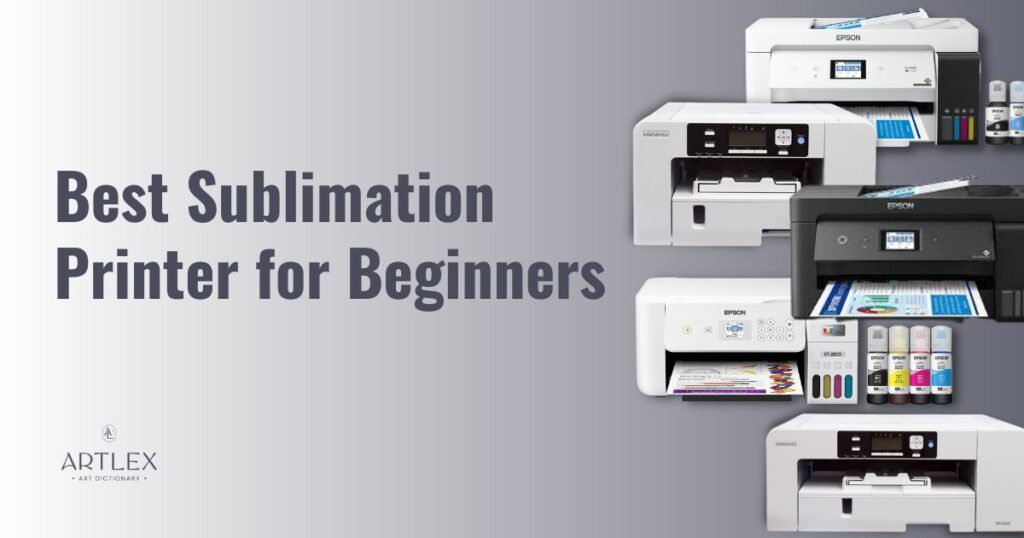
Welcome to the amazing world of sublimation printing! Learning how to sublimate on different substrates will open many doors of opportunities and creative endeavors for you. However, before even trying to get started, you will notice that there are some tools you need, and one of those is a sublimation printer.
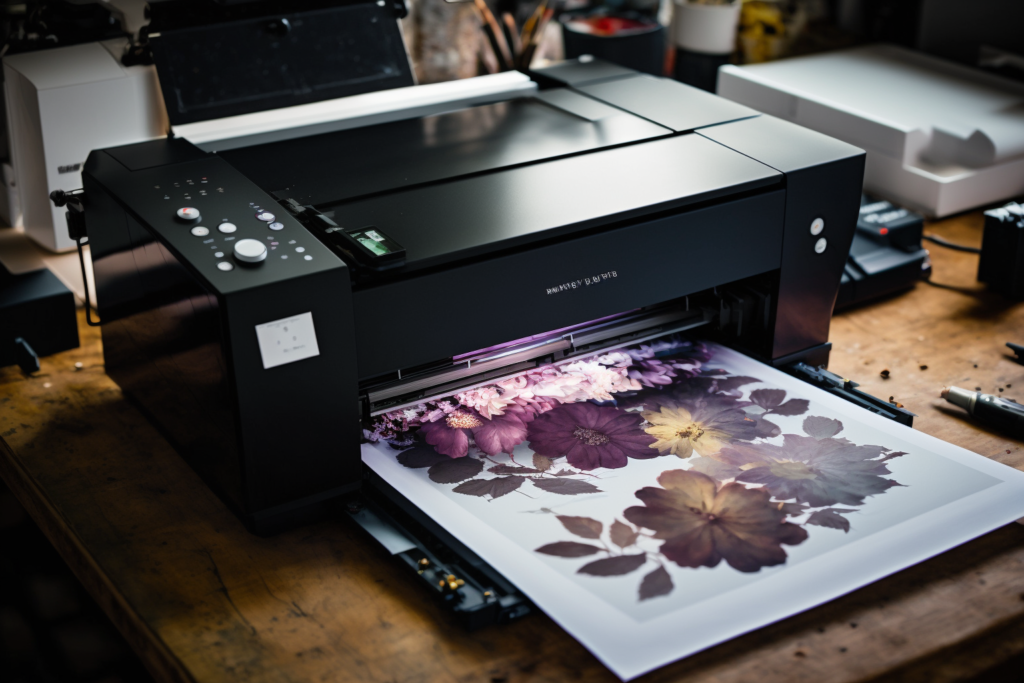
Whether you’re a hobbyist, a small business owner exploring custom products, or an artist seeking new ways to express your vision, choosing the ideal sublimation printer is essential for any craft idea or project to come to life.
The world of sublimation printers can be overwhelming, given the many, many options available and the specifications needed to be considered when choosing one. But don’t worry; we’re here to help!
In this article, we’ll guide you through the basics of sublimation printing, and we’ll introduce you to a handpicked selection of top sublimation printers that are budget and user-friendly, share valuable tips, insights, and resources to help you overcome common challenges and ensure your transition into the world of sublimation printing is as seamless and enjoyable as possible.
So, get ready and join us on this captivating adventure into the world of sublimation printing!
The 5 Best Sublimation Printers for Beginners in 2023
- Best Sublimation Printer for Beginners Overall: Sawgrass SG-500
- Best Wide Format Sublimation Printer for Beginners: Sawgrass SG-1000
- Best Price-Value Printer for Sublimation: Epson EcoTank ET-2800
- Best Price-Value Wide Format Printer for Sublimation: Epson EcoTank ET-15000
- Best Sublimation Printer for Small Business: Epson Surecolor F-170
1. Best Sublimation Printer for Beginners Overall – Sawgrass Virtuoso SG-500
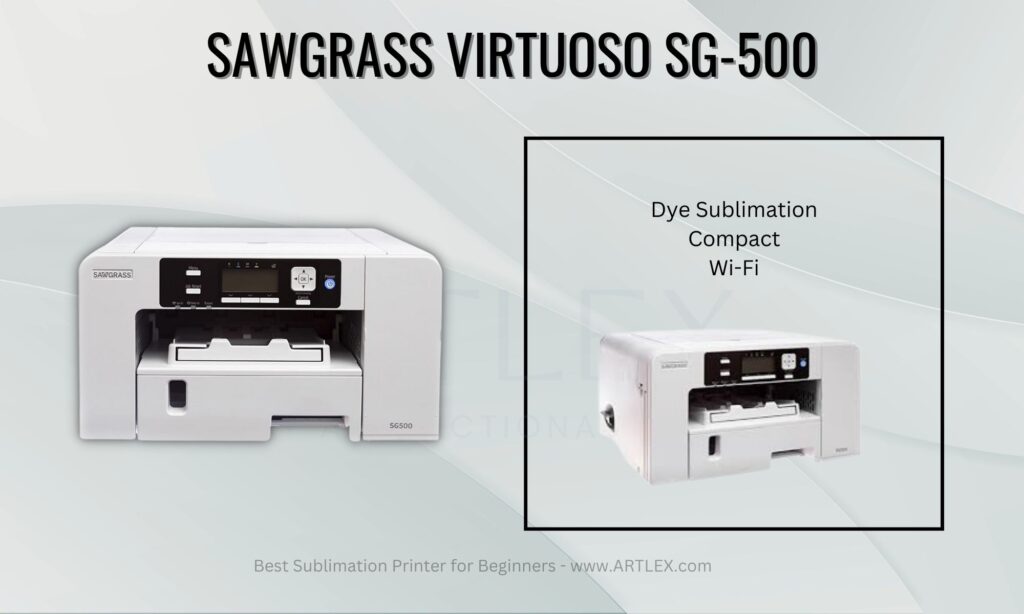
Selection Criteria
- Print Size: Maximum print size 8.5″ x 14″.
-
- Our score: 8/10
-
- Print Quality: Up to 4800 x 1200 dpi
- Our score: 10/10
- Ink Compatibility: Compatible only with brand cartridges
- Our score: 7/10
- Ease of use: Extremely easy to use
- Our score: 10/10
- Connectivity and Compatibility: USB or Wi-Fi. Compatible with Windows and Mac
- Our score: 8/10
About the Sawgrass SG-500
The sawgrass SG500 is a specialized sublimation printer that is specially designed for artists, crafters, and small businesses that are just starting in the world of sublimation. We’ve chosen this printer as our Overall Best not only because it’s made for sublimation but because it’s so easy to set up and use that it becomes the first sublimation printer for beginners.
The Sawgrass SG500 includes a cloud-based editing software, CerativeStudi, which makes it more accessible and user-friendly since not all beginners use design programs like Photoshop or Illustrator. This printer also features wifi connectivity, allowing you to print from pretty much anywhere without any major hassle.
The printer’s compatibility with various sublimation inks ensures vibrant, long-lasting prints on materials like polyester fabric, coated ceramics, and metal, making it an excellent choice for artists and crafters seeking professional results.
Another point in which Sawgrass stands out is in customer service. Unlike many entry-level Epson printers that require conversion from “inkjet” to “sublimation,” the Sawgrass SG500 is designed specifically for sublimation printing and comes with a warranty. This means that customers can rely on Sawgrass for technical support and repairs in case of any printer malfunctions.
The only downside of this Sawgrass sublimation printer is the initial cost since they are usually on the expensive side both upfront and in the long run. Also, the inks are not as affordable as the ones used for “converted” sublimation printers.
Pros
- Dedicated sublimation printer
- Excellent customer service and technical support
- Easy to set up and use
Cons
- On the expensive side
- Regular format
- Limited ink options
2. Best Wide Format Sublimation Printer for Beginners – Sawgrass Virtuoso SG-1000
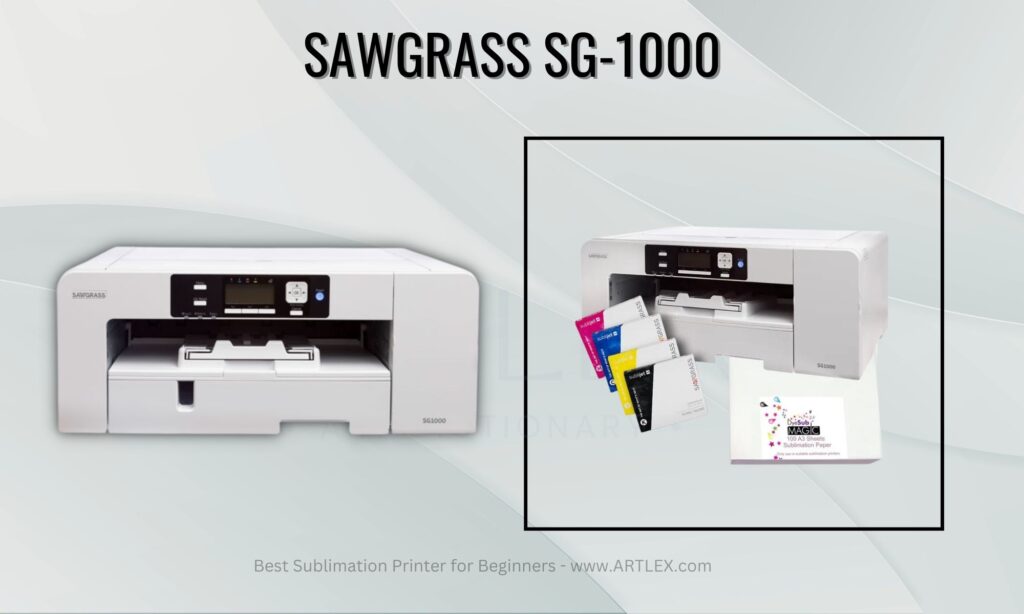
Selection Criteria
- Print Size: Maximum print size is 11″ x 17″ (up to 13″x51″ with the Bypass Tray (sold separately)
- Our score: 9/10
- Print Quality: Up to 4800 x 1200 dpi
- Our score: 10/10
- Ink Compatibility: Compatible only with brand cartridges
- Our score: 8/10
- Ease of use: Very easy to use
- Our score: 10/10
- Connectivity and Compatibility: USB or Wi-Fi. Compatible with Windows and Mac
- Our score: 8/10
About the Sawgrass SG-1000
The Sawgrass SG1000 is a sublimation printer that stands out as an exceptional choice for creatives seeking a versatile and reliable wide-format sublimation printer.
One of the standout features of the SG1000 is its ability to handle larger print sizes, enabling you to work on projects that require a bigger printing area compared to its counterpart, the SG500. This increased flexibility is especially beneficial for artists and businesses working on larger projects, such as custom-printed clothes, home décor items, or promotional materials.
Another advantage of the SG1000 is its enhanced print head technology, which ensures more consistent and accurate color reproduction. This results in higher quality, professional-grade prints. Additionally, the SG1000 shares many of the user-friendly features of the SG500, such as the cloud-based CreativeStudio software and seamless wireless connectivity, making it just as accessible and easy to use.
The major downside would be the price, as Sawgrass printers are quite expensive and the fact that it is constantly in and out of stock, and you can’t buy it unless it’s from a Sawgrass Dealer in your area; even so, the stock is not guaranteed, and you might have to end up paying elevated shipping costs.
Pros
- Dedicated sublimation printer
- Easy to set up and use
- Large print size
Cons
- Maintenance required
- On the expensive side
- Bypass Tray for large prints is $200
3. Best Price-Value Printer for Sublimation – Epson EcoTank ET-2800
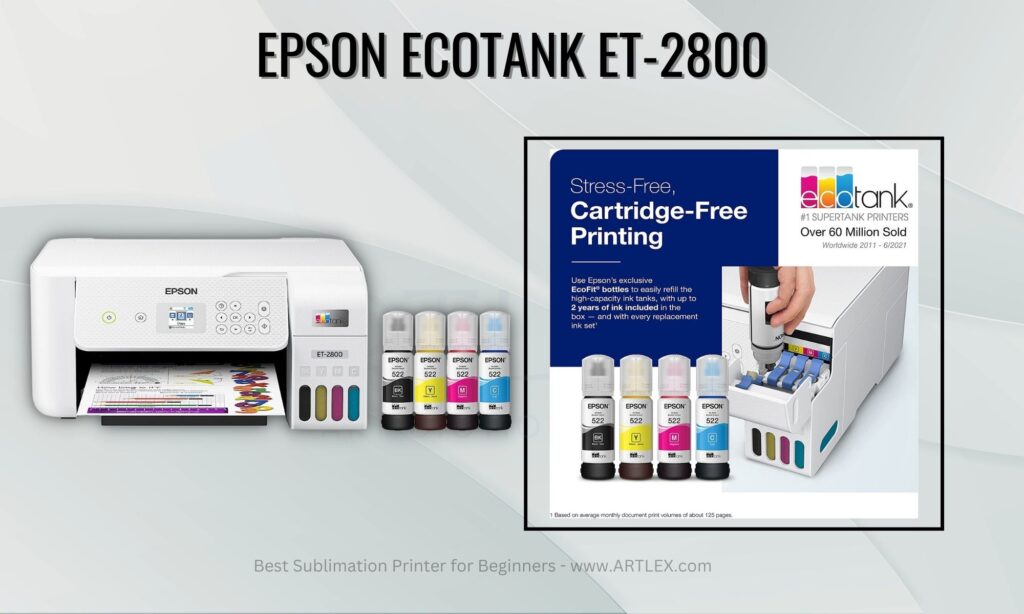
Selection Criteria
- Print Size: Maximum print size 8.5″ x 14″
- Our score: 8/10
- Print Quality: Up to 5760 x 1440 dpi
- Our score: 10/10
- Ink Compatibility: Compatible with multiple brands (after converting)
- Our score: 10/10
- Ease of use: Initial set-up needed
- Our score: 8/10
- Connectivity and Compatibility: USB or Wi-Fi. Compatible with Windows, Mac, iOS, and Android
- Our score: 10/10
About Epson Ecotank ET-2800
In the sublimation printing world, Epson printers hold a special place since they are the only “inkjet” printers that can be used with sublimation inks without having major issues. Although not explicitly designed for sublimation, the ET-2800 can be easily converted for this purpose by using the appropriate sublimation inks and paper.
Although there is a bit of a challenge in the converting process, with the proper configurations, the ET-2800 can be the perfect starter sublimation printer. The Ecotank system replaces the cartridges and makes ink refilling an easy and straightforward process which is incredibly valuable when converting from inkjet to sublimation. Since the system allows high-volume refills, buying cartridge replacement won’t be necessary, making it much more cost-effective in the long run than other brands and models.
The printer’s high-quality output, with a resolution of up to 5760 x 1440 dpi, ensures sharp, vibrant images., and although the printing speed is not the fastest, the quality and price-value ratio is unmatched. Additionally, Epson is known for its dedication to providing quality customer service.
Pros
- High-resolution print quality
- Versatile and adaptable
- Compatible with many sublimation ink brands
- Easily refillable ink tanks
Cons
- Mid-high price range
- ICC configuration needed
4. Best Price-Value Wide Format Printer for Sublimation – Epson EcoTank ET-15000
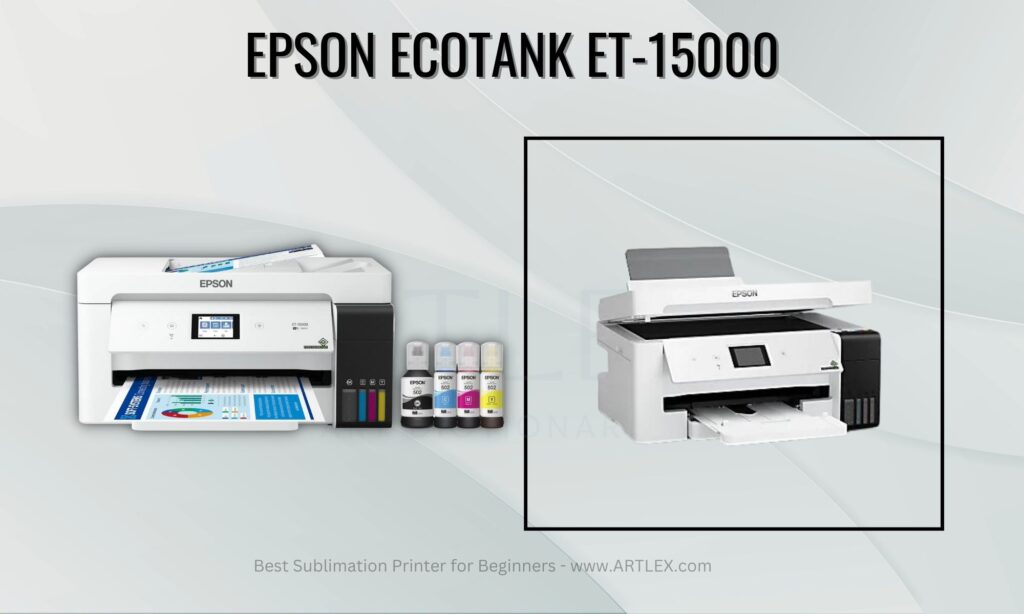
Selection Criteria
- Print Size: Maximum print size 13″ x 19″
- Our score: 10/10
- Print Quality: Up to 4800×1200 dpi
- Our score: 10/10
- Ink Compatibility: Compatible with multiple brands (after converting)
- Our score: 10/10
- Ease of use: Initial set-up needed
- Our score: 9/10
- Connectivity and Compatibility: USB or Wi-Fi. Compatible with Windows, Mac, iOS, and Android
- Our score: 10/10
About Epson EcoTank ET-15000
And within the affordable, beginner-friendly range, we have the Epson Eco Tank 15000, which is a versatile printer we believe is a solid choice for artists, crafters, and small businesses looking to venture into sublimation printing and that need large format printing.
This printer is not cheap at all, it can even be considered an investment more than a budget-friendly starter sublimation printer. The reason we call it an “affordable” printer is that the $599 this printer costs can be considered a steal compared to the prices of wide-format sublimation printers made for businesses and industries.
While not specifically designed for sublimation, the ET-15000 is a wide-format sublimation printer that can be adapted for this purpose by using the right sublimation inks and paper. Its EcoTank ink system makes it an appealing option for creative professionals who require efficiency and don’t want to break the bank with an expensive printer or hard-to-find ink cartridges.
The LCD screen makes the initial setup much easier and the converting process is the same as any other Epson EcoTank printer. Fill the ink, install the ICC profiles, and start printing! The major downside would be the lack of stock and the inflated prices you find in stores, so we advise you to check the authorized suppliers here.
This printer is usually the best option for those looking to do major sales besides wide format printing, so if it’s not on your budget or you don’t need wide format printing, then you can go for a smaller yet more affordable sublimation printer like the following on the list.
Pros
- Wide format printer
- Very easy to use
- High-quality print
Cons
- Hard to find due to high demand
- Not always in stock
- On the expensive side
5. Best Sublimation Printer for Small Business – Epson Surecolor F-170
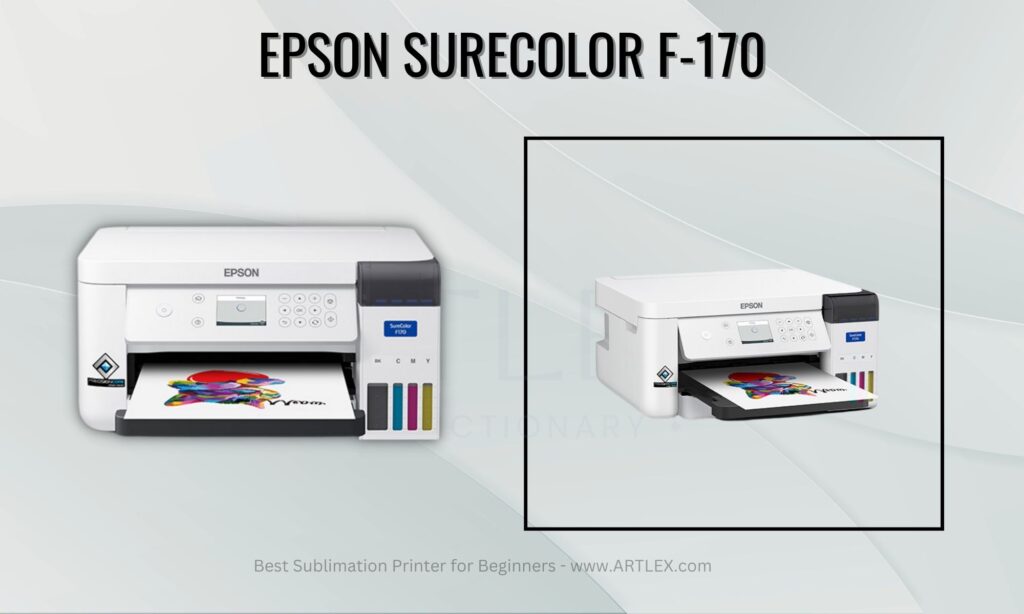
Selection Criteria
- Print Size: Maximum print size 8.5″ x 14″
- Our score: 8/10
- Print Quality: Up to 4800×1200 dpi
- Our score: 10/10
- Ink Compatibility: Compatible with several brands, EPSON ink recommended
- Our score: 10/10
- Ease of use: Very easy to use
- Our score: 10/10
- Connectivity and Compatibility:
- Our score: 10/10
- Price: USB or Wi-Fi. Compatible with Windows, Mac, iOS, and Android
- Our score: 10/10
About the Epson Surecolor F-170
The Epson SureColor F170 is a solid contender for the “best beginner sublimation printer overall”. This reliable, user-friendly machine produces great results as it is designed specifically for sublimation printing, meaning it’ll produce high-quality, vibrant prints that can be transferred to a variety of substrates, like mugs, T-shirts, phone cases, and more.
The F170 has a 150-sheet capacity of 8.5″ x 11″, which means you will have enough room for popular items like mugs, tumblers, cases, etc., and you won’t have to refill paper constantly. It also has USB and Wi-Fi connectivity, and the app makes it even easier to print from your phone, iPad (for our Procreate lovers), or computer without the hassle of cords.
It’s pretty fast, although it’s not the fastest printer out there; for a beginner or someone with a small-scale operation, we think this Epson sublimation printer is more than sufficient. The major downside would be the price; although it’s not the most expensive printer out there, it’s not as affordable as other inkjet printers that can be converted to sublimation, but on the bright side, you won’t have to worry about voiding your warranty or any future issues since Epson customer service (as we mentioned above) is great.
Pros
- Special for sublimation printing
- Easy to set up
- Easily refillable ink tanks
- Great customer support
Cons
- Limited warranty
What is sublimation printing?
Although the name might sound complex, once we break it down, it becomes much easier to understand. Since we all are more or less familiar with the printing process, our focus now shifts to understanding sublimation.
What is sublimation?
Most of us are aware of the three main states of matter: solid, liquid, and gas, and the transformation processes like condensation, vaporization, etc., but what is sublimation exactly?
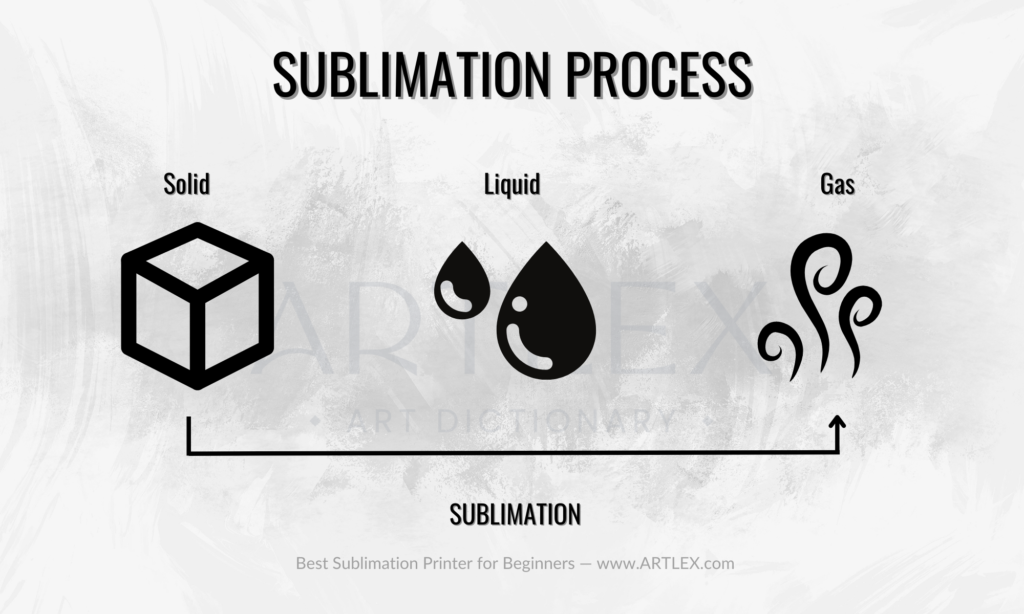
Sublimation, in scientific terms, refers to the direct transformation of a solid into a gas, bypassing the liquid phase entirely. So, how does this phenomenon relate to printing?
In sublimation printing, the ink is the star of the show. It is made especially so that when heated, it undergoes a sublimation process which makes the transference between mediums easier.
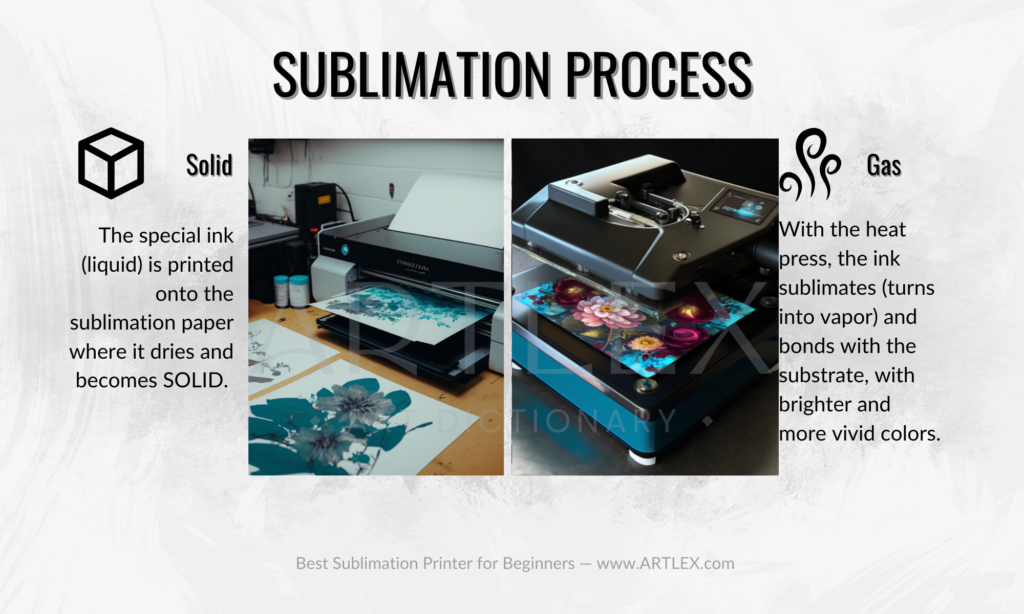
This ink transforms from a solid state (image printed on sublimation paper) directly into a gaseous state when exposed to high heat. The gaseous ink then permeates the surface of a substrate (fabric, metal, wood, etc.) and solidifies as it cools, creating a permanent, high-quality, and vibrant print.
Which Materials or Substrates Can Be Used for Sublimation?
Sublimation works best on fabrics that can withstand heat, like polyester or polyester-mixed fabrics; you can also sublimate on surfaces with a special coating, like ceramic, metal, and plastic, that are solid and heat resistant.
In case you want to use other fabrics and uncoated materials, a special coating must be applied on top to allow the sublimation ink to bond properly with the substrate.
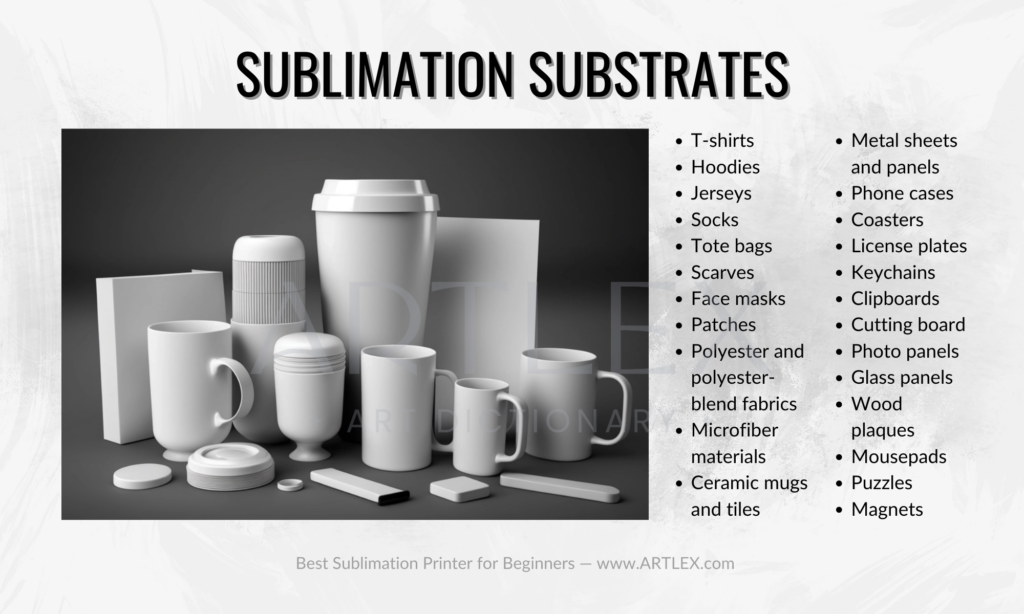
Here is a small list of surfaces suitable for sublimation:
Polyester fabrics: T-shirts, sportswear, uniforms, socks, and other apparel made from polyester or polyester-blend materials are ideal for dye sublimation printing.
Ceramic: Sublimation printing can be used on specially coated ceramic items such as mugs, tiles, and plates.
Metal: Coated aluminum sheets or panels are popular for creating photo panels, signs, and award plaques using sublimation printing.
Plastics: Specially coated plastics, such as phone cases, keychains, and luggage tags, can be used for sublimation printing.
Textile substrates: Mouse pads, coasters, and bags made from polyester or polyester-blend materials work well with sublimation printing.
Wood: Coated Wood or MDF can be used for creating wall art, decorative panels, or puzzles with sublimation printing.
Which Printers are Suited for Sublimation?
There are several types of printers available in the market, but not all are suitable for sublimation printing. The most common types of beginner-friendly printers include inkjet, laser, and dye-sublimation printers.
Inkjet Printers:
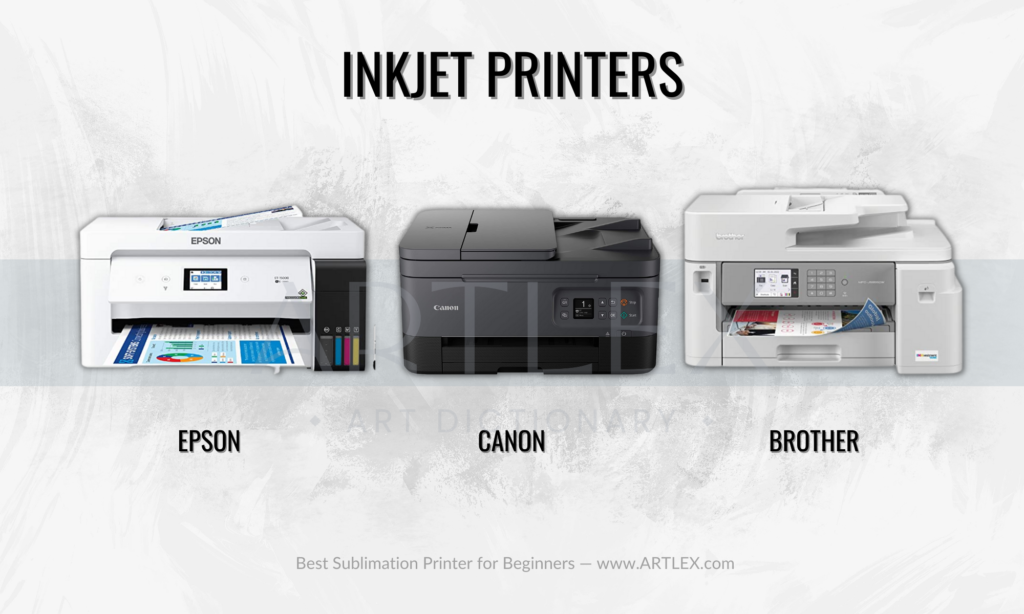
Inkjet printers are the most common type of printer that you can find in homes and offices. They work by spraying tiny drops of ink (CMYK) onto the paper to create an image. Although they are not explicitly designed for sublimation printing, some inkjet printers can be adapted for sublimation printing by using sublimation ink cartridges or a Continuous Ink Supply System, which makes them the most affordable option to start sublimation printing while on a budget.
Since these printers are on the cheap side, most don’t worry about voiding the warranty, but it will become an issue if you run into a printing error, if the conducts or cartridges clog, or if you have to buy multiple printers because of that.
Laser Printers:
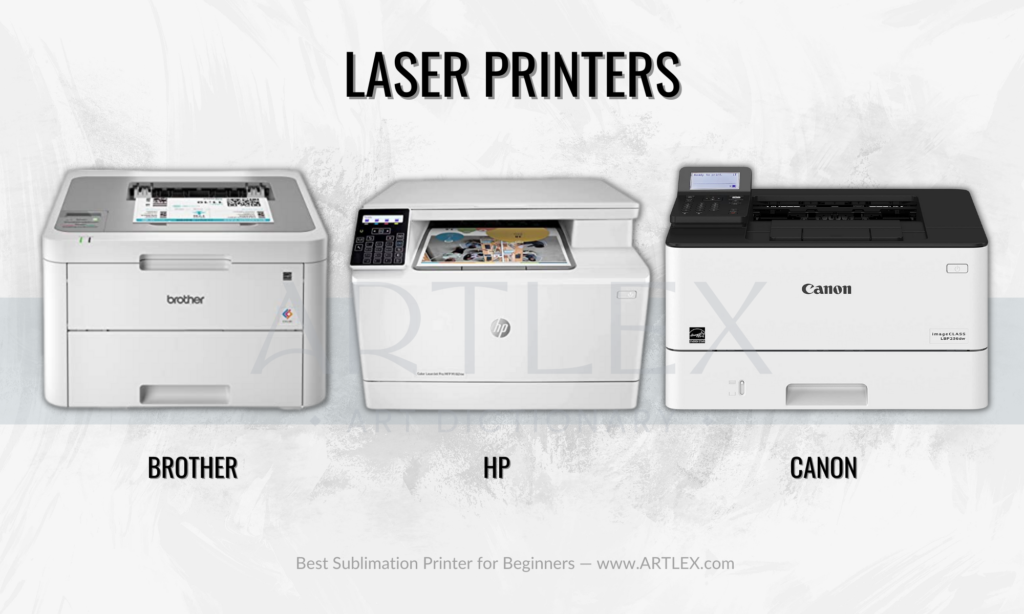
Laser printers use toner, which is a powdered substance that creates images on paper by fusing the toner into the paper using heat and pressure. Laser printers are known for their fast printing speed and crisp text quality.
However, they are not suitable for sublimation, as they use toner instead of ink, and sublimation-compatible toners are extremely expensive compared to the lower cost of inks and dyes. Additionally, toner cartridges are also expensive to replace and quite hard to find, so we don’t recommend using laser printers as they can end up being the most expensive for beginners and small businesses.
Dye-Sublimation Printers:
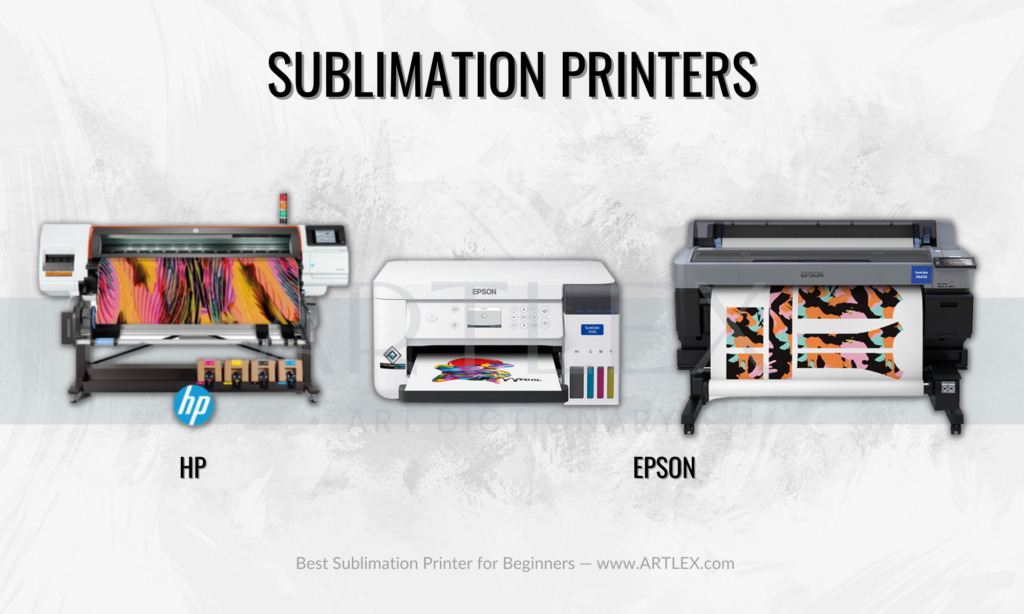
These printers are specifically designed for sublimation. They use a unique printing process and specially designed dyes that ensure your images come out beautifully and take the worry of clogging conduct and configuration processes.
As they are specially made for sublimation printing, you won’t have to worry about voiding the warranty, converting a regular inkjet printer into a sublimation printer, setting up the printer, changing the configuration, finding the right inks, etc. Dye-sublimation printers are known for producing vibrant, long-lasting prints with excellent color accuracy.
Color Profiles and Why They’re Important
Color profiles, also known as ICC (International Color Consortium) profiles or color management profiles, are files that describe how colors should be interpreted and displayed by different devices. In simpler terms, they are like “color translators” that help make sure the colors you see on your screen look the same when you print them or view them on other devices.
Every device (like monitors, printers, or cameras) displays colors a little differently. Color profiles are used to help match the colors across these devices so the colors stay consistent. There are several types of color profiles:
Device Profiles describe the specific color characteristics of a particular device, such as a monitor, printer, or scanner. They help to ensure that colors are accurately reproduced on that device.
Working Space Profiles define the color space in which you edit and manipulate images within an application like Adobe Photoshop. Some common working space profiles are Adobe RGB, sRGB, and ProPhoto RGB.
Input Profiles are associated with input devices (devices that send information to your computer) like digital cameras and scanners. They describe how the device captures color information and help to ensure accurate color representation in the digital file.
Output Profiles are associated with output devices (devices that receive information from your computer), such as printers. They describe how the device reproduces colors, ensuring that the final printed output matches the original image as closely as possible.
Color profiles are important because, without them, your computer wouldn’t know how to “talk” to your printer. They help to make sure the colors in your digital images and prints look consistent and accurate, no matter which device you’re using, this way, the colors in your final sublimation print will match what you see on your computer, and your design will look just the way you want.
Color Management for Sublimation Printers
In order to help to make sure the colors in your digital images and prints look consistent and accurate, no matter which device you’re using, you might need to follow some steps.
1.Use the right color profile:
Sublimation printers, paper, and inks all come with an ICC color profile that will help you get the best results. In case you’re using a specialized sublimation printer, then you will probably already have the printer ones installed, but they are not enough.
There are different profiles for different paper/printer/ink combinations; you might have to reach your ink supplier and ask if they have your combination or get paper and ink from the same company to narrow down the alternatives.
Here’s a video that explains how to find and install ICC profiles from different paper companies. https://www.youtube.com/watch?v=uToEzmzuZBU, and here is another one that illustrates how to deal with ICC profiles for sublimation printing https://www.youtube.com/watch?v=YqW5199ceOc
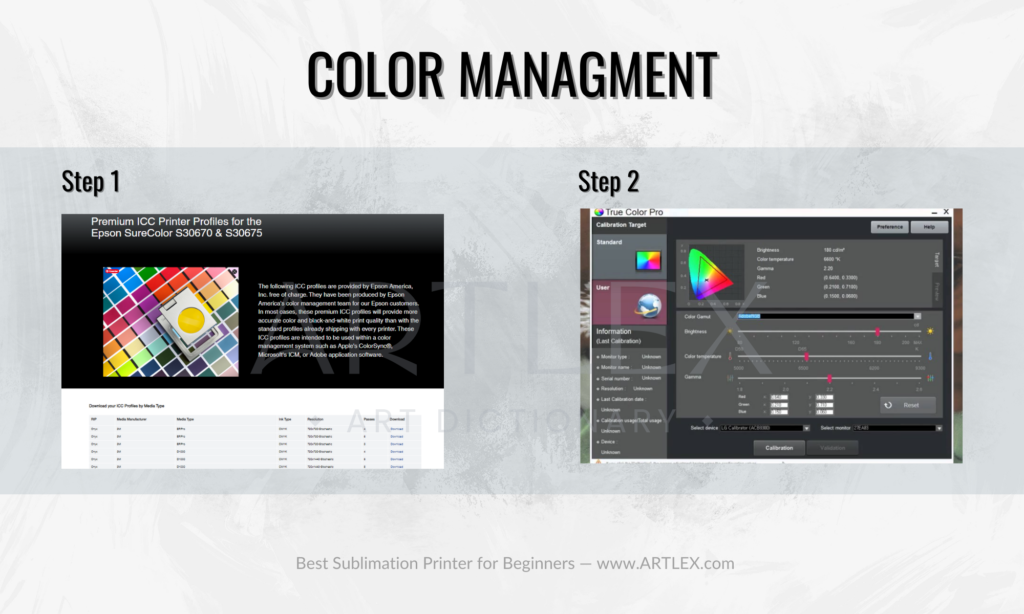
2. Calibrate your monitor:
Although this is going a step further and not so beginner-friendly, in order to ensure accurate color representation on your screen, it’s a good idea to calibrate your monitor. You can use built-in calibration tools in your operating system or third-party calibration software and hardware tools for more accurate results.
3. Set up the color profile in your design software:
Open your preferred software (such as Adobe Photoshop, Illustrator, etc.), and make sure to set up the working color space to match the color profile you’re using. This step ensures that your design will be in the same color space that your printer uses.
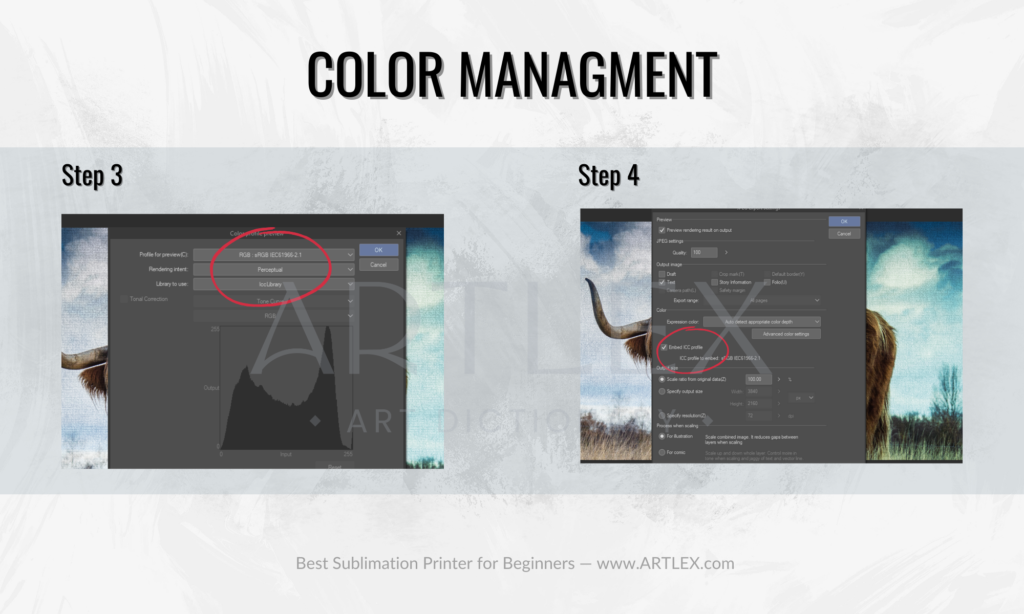
4. Embed the color profile in your image file:
When saving your design, make sure to embed the color profile into the image file. This step will ensure your design’s colors are accurately interpreted by other software or devices.
5. Configure the printer settings:
Open the printer preferences in your operating system or the printing software you are using. Set the color management settings to use the appropriate color profile for your sublimation printer, ink, and paper combination, or select no color management and use your preferred software to establish the configurations.
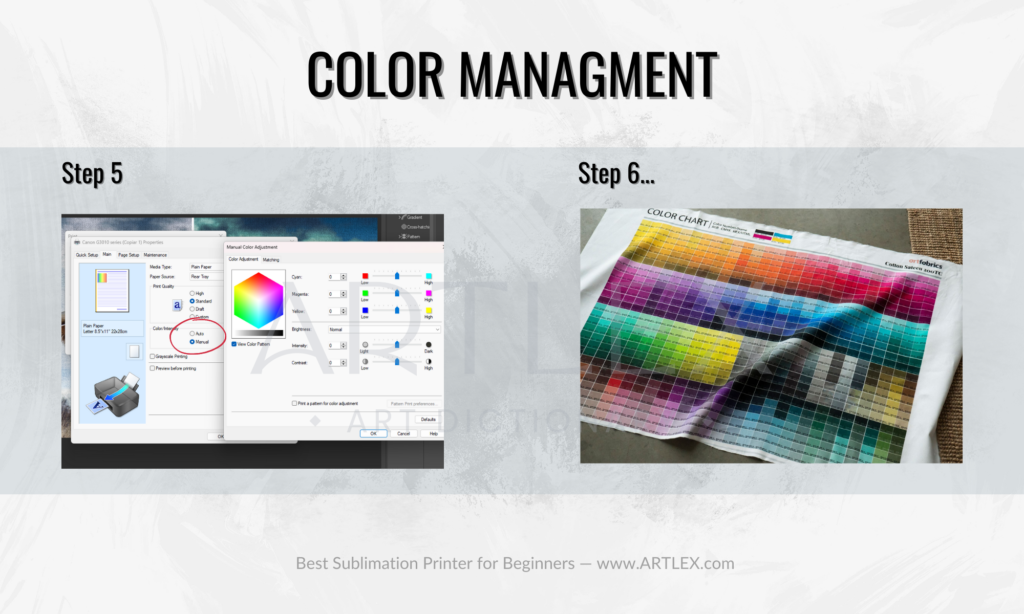
6. Run a Print Test:
Before starting a large print run, make test prints to check the accuracy of the colors. If the colors are looking off, you may need to adjust the printer settings or edit your design in the graphic software accordingly.
It’s always useful to have a color chart printed and sublimated on a couple of surfaces for reference. Keep in mind that some colors, especially bright and fluorescent colors, can be difficult to reproduce accurately in the sublimation process.
7. Print your design:
With the correct color profile set up in your design software and printer settings, you can now print your design onto sublimation paper. Make sure to use the recommended sublimation paper and ink for your printer to achieve the best results.
How to Choose the Best Sublimation Printers?
Print Size
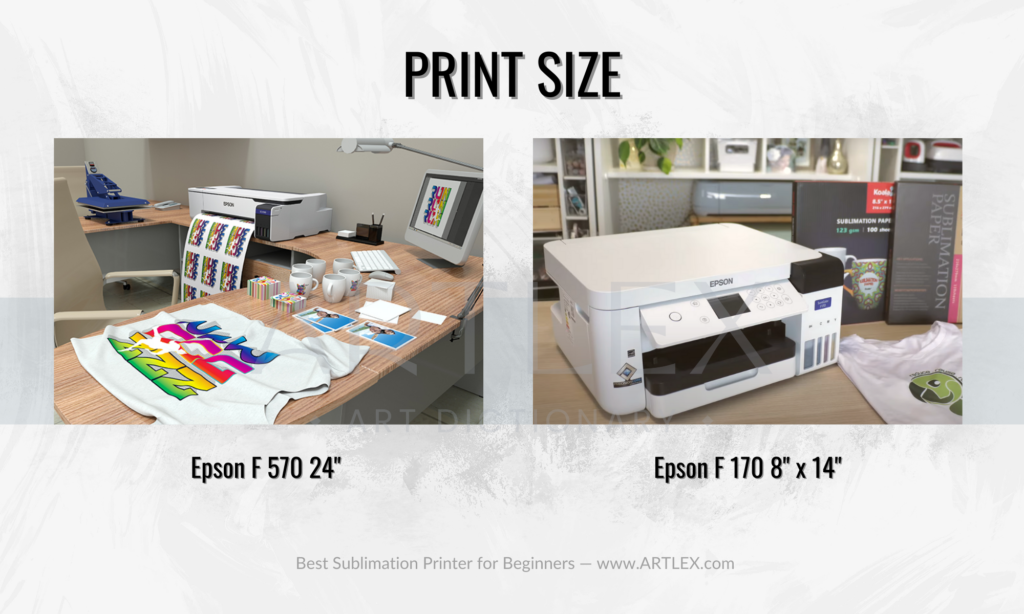
Sublimation prints can be applied to several materials with various sizes, and although an 8.3 x 11.7 paper might be wide enough for most designs, sometimes you might need larger prints.
Some printers can handle only small-format prints, while others are designed for wide-format or large-format printing. The prices of these printers are usually more elevated than small-formate printers, so make sure you choose a printer that can accommodate the size of the items you plan to print and your budget.
Print quality and Speed
High-resolution printers can produce more detailed and sharper images, but they also go hand in hand with the printer’s color management capabilities, as they play a significant role in achieving accurate colors. Although choosing a high-resolution printer is always a good idea, most printers nowadays offer a decent print quality, so if you’re going to convert an inkjet printer to a sublimation printer, you might want to take a look at the prices of “Pro” printers and decides if it’s worth getting an expensive printer and voiding the warranty right away.
Printing speeds differ from brand to brand, so if you plan to do high-volume printing or need to meet tight deadlines, consider a printer with faster print speeds. However, keep in mind that faster printers will most likely come at a higher price.
Ink Compatibility and Operating Costs
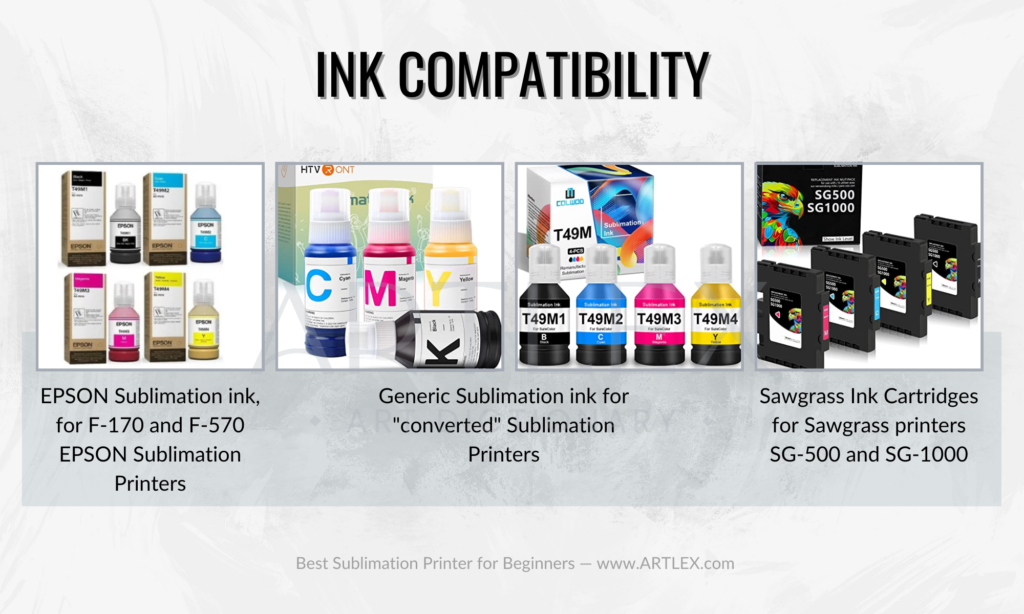
Make sure the printer is compatible with the sublimation ink you plan to use. Some printers are designed specifically for sublimation printing and come with dedicated sublimation ink systems, while others may require aftermarket conversion kits. Eco-Tank or printers with an integrated print system will be easier to convert to sublimation printers, easy to refill, and much less expensive than printers that use cartridges.
Also, consider the ongoing costs of consumables, such as sublimation ink, paper, and replacement parts. Some printers may have lower upfront costs but higher long-term operating expenses.
Some also might have a higher impact on your budget since they might require brand-compatible-only materials, which are more expensive than regular ones and won’t void your warranty when used.
Ease of use and maintenance
A printer that is easy to operate and maintain (like a specialized sublimation printer) will be much more pleasant to use than a printer that comes with challenges (like a converted Inkjet printer).
Look for user-friendly software, easy access to printer components for cleaning and maintenance, and great customer support from the manufacturer.
If you’re converting an inkjet printer, then make sure to research within the community the inks that will go the best with the printer of your choosing, and also make sure to print something every day to keep the ink from clogging the print head or distribution system.
Connectivity and compatibility
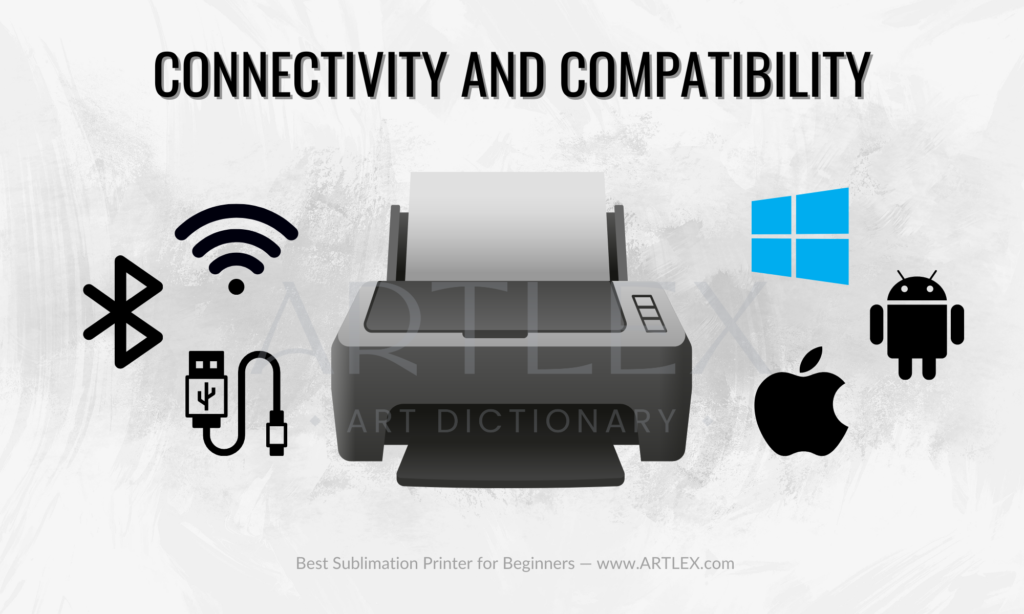
Ensure that the printer is compatible with your computer and operating system. Also, check if the printer supports different connectivity options, such as USB, Ethernet, or Wi-Fi, depending on your needs. Research and explore the drivers and user manuals and make sure to keep the customer support number or email at hand.
Conclusions
In conclusion, finding the best sublimation printer for beginners is a crucial step towards a successful and enjoyable experience. With the right printer, beginners and small business owners can unlock a world of creative possibilities, turning their designs into stunning, high-quality prints on a variety of substrates.
When choosing the perfect sublimation printer, consider factors such as ease of use, print quality, affordability, and the type of materials you plan to use. Remember, the right heat press and accessories are equally important for achieving consistent and professional results.
As you embark on your printing journey, don’t forget to invest time in learning the process, techniques, and best practices. Utilize the wealth of online resources, tutorials, and forums to refine your skills and troubleshoot any issues you may encounter along the way.
With dedication and the right tools, you’ll soon be transforming your creative vision into vibrant, long-lasting prints that impress and inspire. Happy printing!
So you’ve got the printer; now what?
In addition to a sublimation printer, you will need specific supplies and accessories for sublimation printing. Some of these include:
Sublimation Inks:
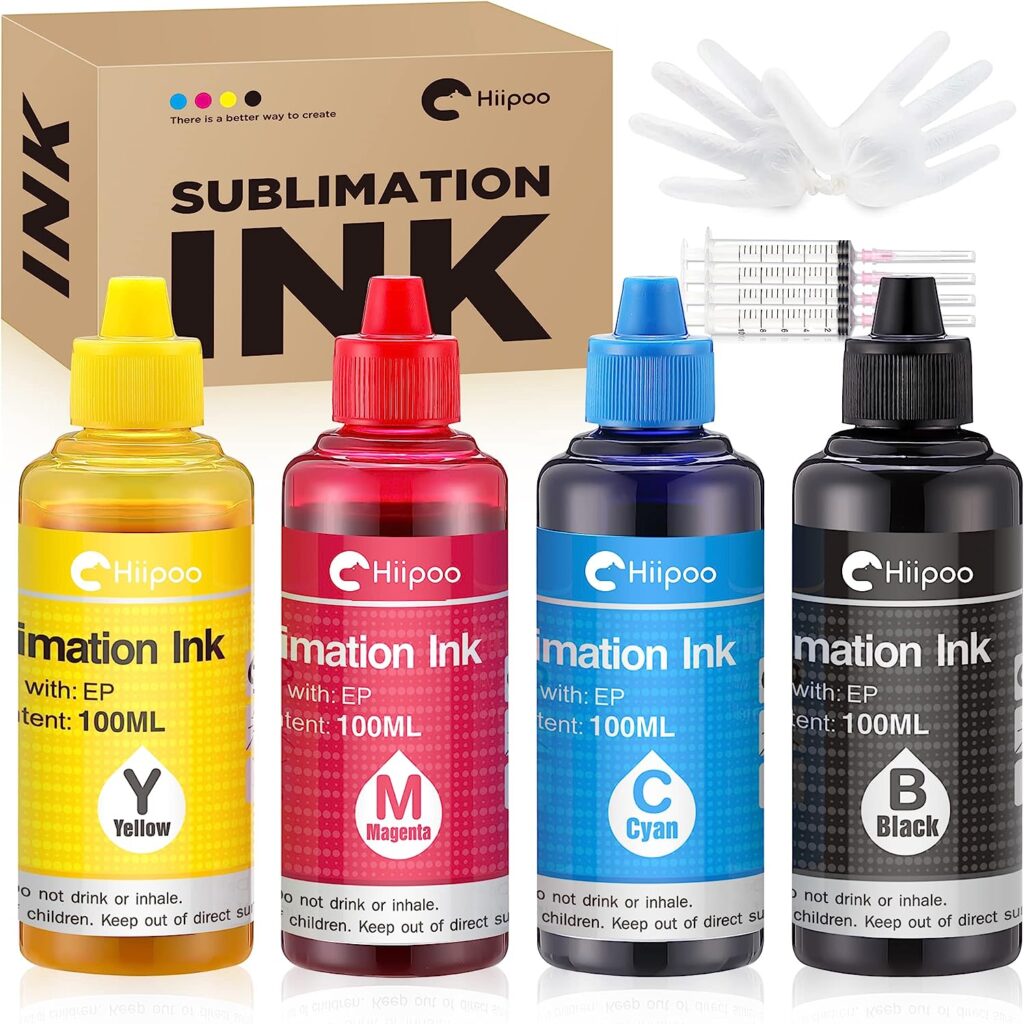
Special inks designed for sublimation printing. These inks turn into gas when heated, allowing them to bond with the substrate. Hippo Ink is a well known and recommended ink supplier.
Sublimation Paper:
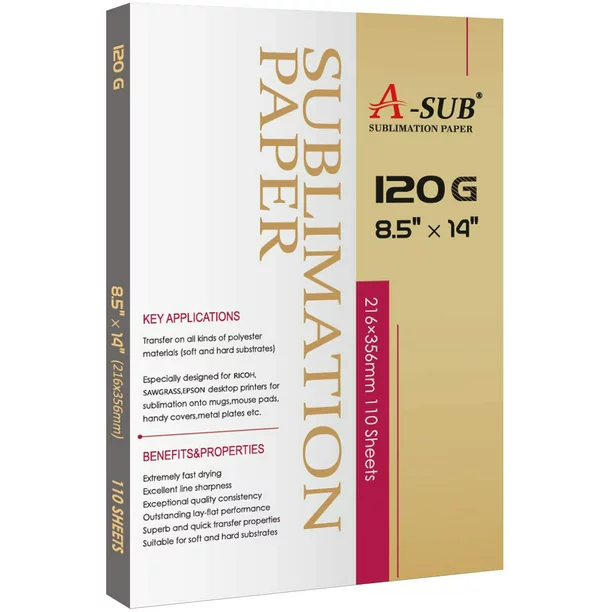
A special type of paper that holds the sublimation ink and releases it when heat and pressure are applied. The most popular sublimation paper is A-Sub, but you can use others like HTV-Ront
Heat Press:

A machine that provides heat and pressure to transfer the design from the sublimation paper to the substrate. Heat presses come in various sizes and types, including clamshell, swing-away, and draw-style, as well as specialized presses for specific items like mugs or hats.
Substrates:
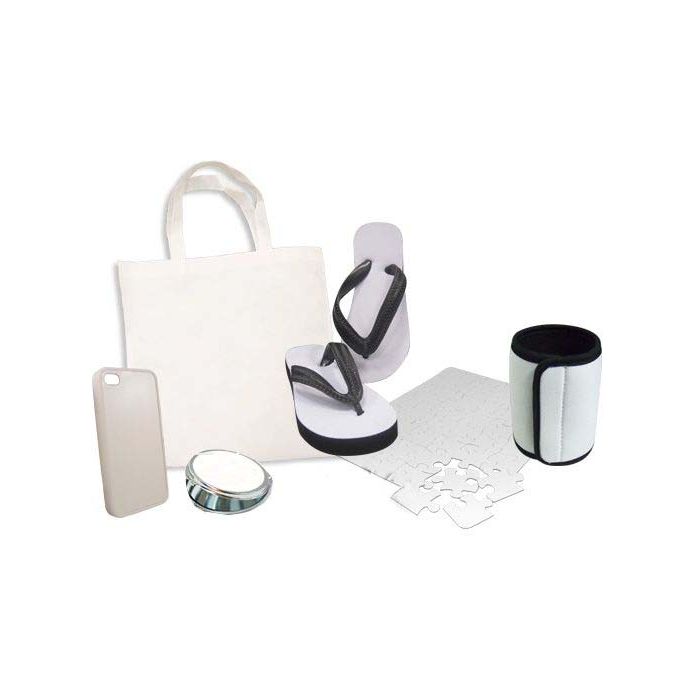
Materials compatible with sublimation printing, such as polyester or polyester-blend fabrics and specially coated surfaces like ceramics, metals, and plastics.
Printing Software:
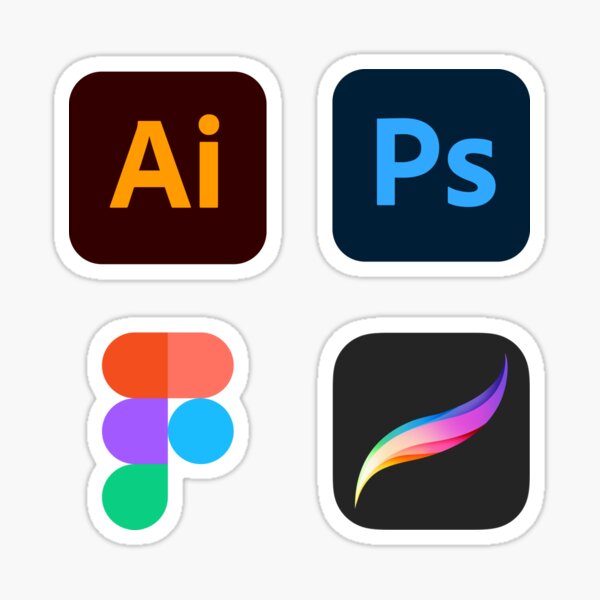
In order to create and edit your designs for sublimation printing, you may need graphic design software. Some sublimation printers come with their own software (e.g., Sawgrass), while others may require third-party software like Adobe Photoshop, Adobe Illustrator, or Procreate.
Online Resources and Tutorials:
Sublimation printing has a learning curve, so it’s essential to learn about the process, techniques, and best practices to achieve optimal results. There are numerous online resources, including articles, forums, and video tutorials, to help you learn about sublimation printing and troubleshooting issues.
Sublimation Printing FAQ’s
Q: Can sublimation printing be used on dark-colored or black substrates?
A: Sublimation printing works best on light-colored or white substrates. Since the process involves dyeing the material rather than printing on top of it, the colors will not show up well on dark or black surfaces.
Q: Is sublimation printing durable and long-lasting?
A: Yes, sublimation printing produces high-quality, long-lasting prints. The sublimation process bonds the ink with the substrate, making the print resistant to fading, peeling, or cracking, even after multiple washes or exposure to sunlight.
Q: Can sublimation prints be washed or ironed?
A: Sublimation prints can be machine washed and dried. However, it is recommended to use cold water and mild detergent to preserve the print’s vibrancy. Ironing is generally not needed, but if required, use a low heat setting and iron the fabric inside out to protect the print.
Q: Can any printer be used for sublimation printing?
A: Not all printers are suitable for sublimation printing. Dedicated dye-sublimation printers or compatible inkjet printers with sublimation inks are required for the process. Laser printers are not suitable for sublimation printing.
Q: Can an existing inkjet printer be converted for sublimation printing?
A: Some inkjet printers can be converted for sublimation printing by using sublimation ink cartridges or installing a Continuous Ink Supply System with sublimation inks.
Q: How important are ICC profiles in sublimation printing?
A: ICC profiles are crucial in sublimation printing, as they ensure accurate color reproduction and maintain print quality. Using the correct ICC profile recommended by the printer or sublimation ink manufacturer helps in achieving consistent and vibrant prints.
Q: How often should a sublimation printer be maintained or cleaned?
A: Regular maintenance of a sublimation printer is essential to keep it functioning optimally. It is recommended to clean the printer’s printhead and other components every 1-3 months or as needed, depending on the usage. Always follow the manufacturer’s guidelines for proper cleaning and maintenance.



